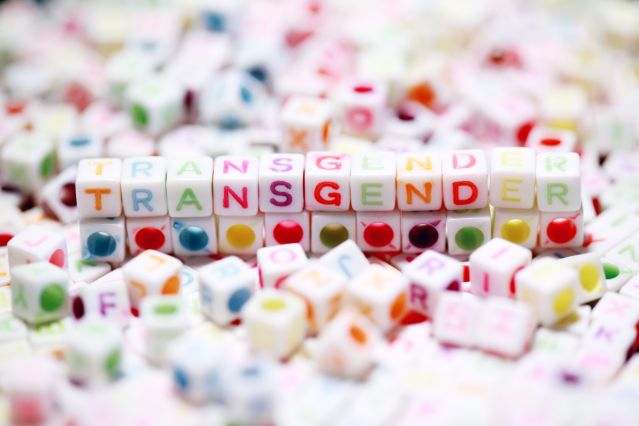Gender
Hormone Therapy: Treating Eating Disorders in Trans People
Hormone therapy can reduce eating disorder symptoms in transgender individuals.
Posted May 8, 2023 Reviewed by Michelle Quirk
Key points
- Transgender individuals feel a disconnect between their preferred gender identity and the gender identity they were assigned at birth.
- Eating disorders are common in transgender individuals.
- Hormone therapy can reduce eating disorder symptoms in transgender individuals.
Gender is a broad term referring to the social and cultural norms assigned to males and females.1 While some individuals feel comfortable with the gender identity they were assigned at birth, not all people do. Individuals who experience a disconnect between their preferred gender identity and the gender identity they were assigned at birth are referred to as transgender (trans) individuals.2 Roughly 1.3 million adults and 300,000 youths (ages 13–17) in the United States identify as trans.3

Importantly, trans people don't have to identify as trans male or trans female but can identify as alternative genders, such as nonbinary, genderqueer, or genderfluid. For some trans individuals, their preferred gender identity is misaligned with their assigned biological sex. Biological sex refers to the specific male and female biological characteristics (i.e., genitalia and hormones) given to men and women.4 Trans individuals who feel a misalignment between their preferred gender identity and their biological sex often seek to align the two with the assistance of hormone replacement therapies (HRT) and, in some cases, surgical procedures. This transitional process is called gender affirmation.5
Gender affirmation is essential for the well-being of many trans individuals. Without gender affirmation, some trans individuals will experience severe distress from gender misalignment and body dissatisfaction, which can lead to tragic outcomes, including the development of psychological disorders (e.g., depression) or suicide.6,7
Eating Disorders and Transgender Identity

Trans individuals are at increased risk for developing psychological disorders due to the high amounts of stress they often experience from trans discrimination or gender misalignment.8,9 A group of commonly diagnosed disorders in trans individuals is eating disorders. Eating disorders are complex medical conditions characterized by disordered eating behaviors and attitudes and a fixation on body weight, size, and shape. According to a recent study, trans university students are more likely to have a diagnosed eating disorder or to engage in eating disorder behaviors (e.g., laxative use and vomiting) compared to cisgender (i.e., non-trans) university students.10
One reason trans individuals are at risk for developing an eating disorder is body dissatisfaction.11,12 Dissatisfaction with birth-assigned secondary sex characteristics (e.g., breast development) in relation to gender identity might lead some trans individuals to overeat, food restrict, purge (e.g., vomit), or exercise excessively to reshape their bodies for gender affirmation. Another reason trans individuals are at risk for developing an eating disorder is stress.13,14 Stressors that trans individuals experience include, but aren't limited to, discrimination for being trans, living with a misaligned gender identity, and lack of access to gender-affirming therapies (GAT).
Why Hormone Replacement Therapy Reduces Eating Disorder Symptoms in Trans Individuals
For some trans individuals, GAT includes HRT.5 The purpose of HRT is to alter an individual's secondary sex characteristics to align these characteristics with an individual's preferred gender identity.
For trans individuals wanting to transition from the male biological sex to the female biological sex (MtF), HRT means feminizing hormone therapy (e.g., estrogen).15,16 Feminizing hormone therapy feminizes a trans woman's physical characteristics, including breast growth, a redistribution of body fat (e.g., hips and thighs), softer facial features (e.g., less pronounced jawline), decreased body hair, softer skin, and reduced muscle mass. In contrast, trans individuals wanting to transition from the female biological sex to the male biological sex (FtM) will use masculinizing hormone therapy (e.g., testosterone).15,16 Masculinizing hormone therapy masculinizes a trans man's physical characteristics, including increased muscle mass, decreased breast size, a deeper vocal range, a more pronounced jawline, oiler skin, increased body hair, and fat redistribution (e.g., upper body).

While the primary purpose of HRT is gender affirmation, recent research has shown that HRT can reduce eating disorder symptoms in trans individuals, as well.17,18 Reasons why HRT reduces eating disorder symptoms in some trans individuals are multifaceted and include psychological and biological explanations.
A psychological explanation for why HRT can reduce eating disorder symptoms in trans individuals is gender affirmation.17,18 It could be that altering the body to align with a preferred gender identity discourages some trans individuals from manipulating their bodies through dietary and exercise interventions. Another explanation for why HRT can reduce eating disorder symptoms in trans individuals is stress, which contributes to eating disorder development.17–19 Trans individuals are exposed to many different stressors, including trans discrimination, limited access to GAT, and living an inauthentic identity. Studies show that trans individuals who undergo GAT have decreased stress and increased body satisfaction.17,18
Beyond psychological explanations for the role of HRT in reducing eating disorder symptoms in trans individuals, there are also biological explanations for these effects. Studies have shown that cisgender women with eating disorders have atypical levels of estrogen and testosterone,20 while cisgender men with eating disorders have atypical levels of testosterone.21 These findings have resulted in research demonstrating that atypical levels of sex hormones might contribute to eating disorder development.20
Why hormone therapy reduces eating disorder symptoms from a biological perspective is unclear. One possibility is that estrogen reduces anxiety, which has a demonstrated role in eating disorder development and maintenance. In one study, estrogen therapy reduced trait anxiety in cisgender females with anorexia nervosa (AN).22 Similarly, low doses of testosterone have been shown to reduce depression in cisgender females with AN, as well as "jumpstart" the brain in ways that reduce eating disorder pathology.23,24 These findings suggest that HRT could improve eating disorder symptoms in trans individuals by reducing anxiety and depression.
Why Clinicians Need to Consider Trans Identity During Eating Disorders Treatment
Despite the high rate of eating disorders in the transgender population, most eating disorder treatments have not been tailored to meet the needs of trans individuals. And studies show that many trans individuals with eating disorders are dissatisfied with their eating disorder treatment.13

One problem with current approaches for treating eating disorders in trans populations is that clinicians are not always mindful of trans individuals' relationships with their bodies.13 For cisgender individuals with an eating disorder, encouraging body positivity might reduce eating disorder symptoms. However, advocating body positivity to a trans person with an eating disorder might increase that individual's body dissatisfaction, as they're experiencing gender misalignment. Clinicians also need to be aware that not all trans individuals' eating disorders are related to gender misalignment. Rather, for some trans individuals, their eating disorder is independent of their trans identity. It is, therefore, crucial for clinicians to understand a trans client's relationship with their body.
Another problem with current approaches for treating eating disorders in the trans population is that trans individuals might not feel comfortable disclosing their trans identities to their clinicians.13 And, if trans individuals do disclose their preferred gender identity to their clinician, clinicians might ignore their preferences. These negative interactions between client and clinician can erode trust in the therapeutic relationship, which can hinder eating disorder recovery.
Overall, one of the best ways clinicians can help trans individuals during eating disorder treatment is to be trained in gender diversity.13 Clinicians also need to acknowledge and be respectful of each client's specific needs.
References
1. Steensma, T.D., Kreukels, B., de Vries, A., & Cohen-Kettenis, P.T. (2013). Gender identity development in adolescence. Hormones and Behavior, 64, 288–297. https://doi.org/10.1016/j.yhbeh.2013.02.020.
2. Winter, S., Diamond, M., Green, J., Karasic, D., Reed, T., Whittle, S., & Wylie, K. (2016). Transgender people: Health at the margins of society. The Lancet, 388, 390–400. https://doi.org/10.1016/S0140-6736(16)00683-8.
3. Williams Institute. (2022). How man adults and youth identify as transgender in the United States. UCLA. Retrieved from: https://williamsinstitute.law.ucla.edu/publications/trans-adults-united….
4. Bale, T.L., & Epperson, C.N. (2016). Sex as a biological variable: Who, what, when, why, and how. Neuropsychopharmacology, 42, 386–396. https://doi.org/10.1038/npp.2016.215.
5. D'hoore, L., & T'Sjoen, G. (2021). Gender-affirming hormone therapy: An updated literature review with an eye on the future. Journal of Internal Medicine, 291, 574–592.
6. Hughto, j.M., Gunn, H.A., Rood, B.A., & Pantalone, D.W. (2020). Social and medical gender affirmation experiences are inversely associated with mental health problems in a non-probability sample of transgender adults. Archives of Sexual Behavior, 49, 2635–2647. https://doi.org/10.1007/s10508-020-01655-5.
7. Kuper, L.E., Stewart, S., Preston, S., Lau, M., & Lopez, X. (2020). Body dissatisfaction and mental health outcomes of youth on gender-affirming hormone therapy. Pediatrics, 145. https://doi.org/10.1542/peds.2019-3006.
8. Valentine, S.E., & Shipherd, J.C. (2018). A systematic review of social stress and mental health among transgender and gender non-conforming people in the United States. Clinical Psychology Review, 66, 24–38. https://doi.org/10.1016/j.cpr.2018.03.003.
9. Millet, N., Longworth, J., & Arcelus, J. (2017). Prevalence of anxiety symptoms and disorders in the transgender population: A systematic review of the literature. International Journal of Transgenderism, 18, 27–38. http://dx.doi.org/10.1080/15532739.2016.1258353.
10. Connolly, M.D., Zervos, M.J., Barone, C.J., Johnson, C.C., & Joseph, C.L. (2016). The mental health of transgender youth: Advances in understanding. Journal of Adolescent Health, 59, 489–495. https://doi.org/10.1016/j.jadohealth.2016.06.012.
11. Jones, B.A., Haycraft, E., Murjan, S., & Arcelus, J. (2016). Body dissatisfaction and disordered eating in trans people: A systematic review of the literature. International Review of Psychiatry, 28, 81–94. doi: 10.3109/09540261.2015.1089217.
12. McClain, Z., & Peebles, R. (2016). Body image and eating disorder among lesbian, gay, bisexual, and transgender youth. Pediatric Clinics of North America, 63, 1079–1090. doi: 10.1016/j.pcl.2016.07.008.
13. Duffy, M.E., Henkel, K.E., & Earnshaw, V.A. (2016). Transgender clients' experiences of eating disorder treatment. Journal of LGBT Issues in Counseling, 10, 136–149. https://doi.org/10.1080/15538605.2016.1177806.
14. Milano, W., Ambrosio, P., Carizzone, F., De Biasio, V., Foggia, G., & Capasso, A. (2020). Gender dysphoria, eating disorders, and body image: An overview. Endocrine, Metabolic, & Immune Disorders - Drug Targets, 20.
15. Hughto, J., & Reisner, S.L. (2016). Quality of life in transgender individuals. Transgender Health, 1. https://doi.org/10.1089/trgh.2015.0008.
16. Unger, C.A. (2016). Hormone therapy for transgender patients. Translational Andrology and Urology, 5, 877–884. doi: 10.21037/tau.2016.09.04.
17. Jones, B.A., Haycraft, E., Bouman, W.P., Brewin, N., Claes, L., & Arcelus, J. (2018). Treatment seeking transgender population: The role of cross-sex hormone treatment. European Eating Disorders Review, 26, 120–128. https://doi.org/10.1002/erv.2576.
18. Testa, R.J., Rider, N.G., Haug, N.A., & Balsam, K.F. (2017). Gender confirming medical interventions and eating disorder symptoms among transgender individuals. Health Psychology, 36, 927–936. https://psycnet.apa.org/doi/10.1037/hea0000497.
19. Lo Sauro, C., Ravaldi, C., Cabras, P.L., Faravelli, C., & Ricca, V. (2008). Stress, hypothalamic-pituitary-adrenal axis and eating disorders. Neuropsychobiology, 57, 95–115. doi: 10.1159/000138912.
20. Baker, J.H., Girdler, S.S., & Bulik, C.M. (2012). The role of reproductive hormones in the development and maintenance of eating disorders. Expert Review of Obstetrics & Gynecology, 7, 573–583. doi: 10.1586/eog.12.54.
21. Skolnick, A., Schulman, R.C., Galindo, R.J., & Mechanick, J.I. (2016). The endocrinopathies of male anorexia nervosa: Case series. AACE Clinical Case Reports, 2, e351–e357. doi: 10.4158/EP15945.CR.
22. Misra, M., Katzman, D.K., Estella, N.M., Eddy, K.T., Weigel, T., Goldstein, M.A.,...& Klibanski, A. (2013). Impact of physiological estrogen replacement on anxiety symptoms, body shape perception, and eating attitudes in adolescent girls with anorexia nervosa: Data from a randomized controlled trial. Journal of Clinical Psychiatry, 74, e765–e771. doi: 10.4088/JCP.13m08365.
23. Miller, K.K., Deckersbach, T., Rauch, S.L., Fischman, A.J., Grieco, K.A., Herzog, D.B., & Klibanski, A. (2004). Testosterone administration attenuates regional brain hypometabolism in women with anorexia nervosa. Psychiatry Research: Neuroimaging, 132, 197–207. https://doi.org/10.1016/j.pscychresns.2004.09.003.
24. Miller, K.K., Grieco, K.A., & Klibanski, A. (2005). Testosterone administration in women with anorexia nervosa. The Journal of Clinical Endocrinology & Metabolism, 90, 1428–1433. https://doi.org/10.1210/jc.2004-1181.




